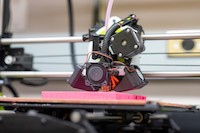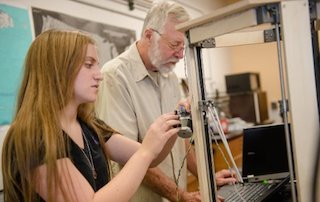 Vulnerabilities in the power grid are one of the most prevalent national security threats. The technical community has called for building up the resiliency of the grid using distributed energy and microgrids for stabilization. Power production from multiple sources increases the difficulty of triggering cascading blackouts, and following an attack or natural disaster, microgrids can provide localized energy security...
Vulnerabilities in the power grid are one of the most prevalent national security threats. The technical community has called for building up the resiliency of the grid using distributed energy and microgrids for stabilization. Power production from multiple sources increases the difficulty of triggering cascading blackouts, and following an attack or natural disaster, microgrids can provide localized energy security...
Joshua Pearce
See the following -
3-D Printing Could Offer Savings On Replica Lab Kit
 Working replicas of expensive scientific equipment could be made for a fraction of conventional cost using cheap 3-D printers, possibly saving developing world labs thousands of dollars each time, says a researcher whose book on the subject was published last year. This and similar advances mean the age of appropriate technology — affordable, sustainable solutions designed and built to meet local needs — may be here, argues Joshua Pearce, a materials science and engineering professor at Michigan Technological University, United States, in an article in Physics World magazine.
Working replicas of expensive scientific equipment could be made for a fraction of conventional cost using cheap 3-D printers, possibly saving developing world labs thousands of dollars each time, says a researcher whose book on the subject was published last year. This and similar advances mean the age of appropriate technology — affordable, sustainable solutions designed and built to meet local needs — may be here, argues Joshua Pearce, a materials science and engineering professor at Michigan Technological University, United States, in an article in Physics World magazine.
- Login to post comments
3D Design Contest for Medical Tools in Africa
 The moment the open source RepRap 3D printer was created, its potential for helping the developing the world was evident. The distributed digital production of open source appropriate technology can make a real difference. Research in this area has been heating up with numerous applications from the Enabling the Future's prosthetic hands, to the Waterscope microscope, to more mundane things like organic farm tools. The ReFab Dar project hopes to accelerate this trend. It is a pilot program that explores how plastic waste can power entrepreneurship using 3D printers in Tanzania. They have built on the early work done by the Michigan Tech Open Sustainability Technology Laboratory's efforts with open source recyclebots to turn plastic waste into 3D printing filament and then into high-value products...
The moment the open source RepRap 3D printer was created, its potential for helping the developing the world was evident. The distributed digital production of open source appropriate technology can make a real difference. Research in this area has been heating up with numerous applications from the Enabling the Future's prosthetic hands, to the Waterscope microscope, to more mundane things like organic farm tools. The ReFab Dar project hopes to accelerate this trend. It is a pilot program that explores how plastic waste can power entrepreneurship using 3D printers in Tanzania. They have built on the early work done by the Michigan Tech Open Sustainability Technology Laboratory's efforts with open source recyclebots to turn plastic waste into 3D printing filament and then into high-value products...
- Login to post comments
3D Printing Educator Spotlight On: Joshua Pearce, PhD, Associate Professor, Michigan Tech
 As the global population continues to expand massively, with an estimated 7.5 billion people alive today, sustainability is becoming an ever-more-pressing concern. It takes a lot of energy to support a large and growing population, especially with the living standards seen in the 21st century. In the US, where capitalism looms large, affordability poses another issue as many goods and services carry with them a hefty price tag. At the convergence of a few major areas looking toward the future of sustainability is Dr. Joshua M. Pearce, who has engaged in extensive work with 3D printing, solar power, and open source research as he has headed thorough studies examining these areas and working to educate students and industry alike...
As the global population continues to expand massively, with an estimated 7.5 billion people alive today, sustainability is becoming an ever-more-pressing concern. It takes a lot of energy to support a large and growing population, especially with the living standards seen in the 21st century. In the US, where capitalism looms large, affordability poses another issue as many goods and services carry with them a hefty price tag. At the convergence of a few major areas looking toward the future of sustainability is Dr. Joshua M. Pearce, who has engaged in extensive work with 3D printing, solar power, and open source research as he has headed thorough studies examining these areas and working to educate students and industry alike...
- Login to post comments
3D Printing the Next Five Years by Prof. Joshua Pearce
 3-D printing should have been here 20 years ago. If my generation had had access to 3-D printers in high school, we would be technical wizards by now. Unfortunately, 3-D printing was locked away by patents, which effectively limited access to rapid prototyping to large corporate R&D centers. I am sure the hundreds of thousands of dollars invested in those early machines paid dividends, but they barely scratched the surface of the potential of additive manufacturing. As readers of 3-D Printing Industry know, we are finally starting to see the potential now...
3-D printing should have been here 20 years ago. If my generation had had access to 3-D printers in high school, we would be technical wizards by now. Unfortunately, 3-D printing was locked away by patents, which effectively limited access to rapid prototyping to large corporate R&D centers. I am sure the hundreds of thousands of dollars invested in those early machines paid dividends, but they barely scratched the surface of the potential of additive manufacturing. As readers of 3-D Printing Industry know, we are finally starting to see the potential now...
- Login to post comments
Clones Welcome in Scientific Hardware
 In the inaugural issue of the Journal of Open Hardware I review emerging business models for open source hardware. Many of these models are borrowed from the free and open source software industry and will no doubt be familiar to you. However, traditional companies should also take a close look at adding open source hardware to their strategy. One way a company can start the transition to the open source way is to open source a single product to drive sales of its other products. A firm can open source the hardware they sell in order to expand the market of other parts of their product line...
In the inaugural issue of the Journal of Open Hardware I review emerging business models for open source hardware. Many of these models are borrowed from the free and open source software industry and will no doubt be familiar to you. However, traditional companies should also take a close look at adding open source hardware to their strategy. One way a company can start the transition to the open source way is to open source a single product to drive sales of its other products. A firm can open source the hardware they sell in order to expand the market of other parts of their product line...
- Login to post comments
Design and Produce 3D Printed, Custom Breast Prosthetics
 As the market for 3D printers has moved from sophisticated, experienced designers into the mass consumer market, individuals are saving substantial money with pre-designed, DIY products made on 3D printers. These opportunities are poised to increase due to the Free Open Source 3D Customizer, a libre, 3D model customizer that anyone can use to create their own 3D printed designs. To demonstrate how the software works and the possibilities that it creates, I'll show how breast cancer survivors and others can use the Free Open Source 3D Customizer to design and produce 3D-printable external breast prosthetics.
As the market for 3D printers has moved from sophisticated, experienced designers into the mass consumer market, individuals are saving substantial money with pre-designed, DIY products made on 3D printers. These opportunities are poised to increase due to the Free Open Source 3D Customizer, a libre, 3D model customizer that anyone can use to create their own 3D printed designs. To demonstrate how the software works and the possibilities that it creates, I'll show how breast cancer survivors and others can use the Free Open Source 3D Customizer to design and produce 3D-printable external breast prosthetics.
- Login to post comments
Do It Yourself And Save: Open-Source Revolution Is Driving Down The Cost Of Doing Science
The DIY movement has vaulted from the home to the research lab, and it’s driven by the same motives: saving tons of money and getting precisely what you want. It’s spawning a revolution, says Joshua Pearce. Read More »
- Login to post comments
How Maker Communities Align with Open Source
 The maker movement intersects deeply with open source. When I think of open source I normally think of the most hardcore bleeding-edge software or hardware development. But the maker movement has a long-established sharing culture, which really is nothing less than pure open source. The source code is a little different, however. For example, consider Nicole Curtis, the maker celebrity and TV star of Rehab Addict...
The maker movement intersects deeply with open source. When I think of open source I normally think of the most hardcore bleeding-edge software or hardware development. But the maker movement has a long-established sharing culture, which really is nothing less than pure open source. The source code is a little different, however. For example, consider Nicole Curtis, the maker celebrity and TV star of Rehab Addict...
- Login to post comments
How Open Source Hardware Increases Cybersecurity
 Hardware hacks are particularly scary because they trump any software security safeguards-for example, they can render all accounts on a server password-less. Fortunately, we can benefit from what the software industry has learned from decades of fighting prolific software hackers: Using open source techniques can, perhaps counterintuitively, make a system more secure. Open source hardware and distributed manufacturing can provide protection from future attacks...security is one of the core benefits of open source. While open source is not inherently more secure, it allows you to verify security yourself (or pay someone more qualified to do so). With closed source programs, you must trust, without verification, that a program works properly.
Hardware hacks are particularly scary because they trump any software security safeguards-for example, they can render all accounts on a server password-less. Fortunately, we can benefit from what the software industry has learned from decades of fighting prolific software hackers: Using open source techniques can, perhaps counterintuitively, make a system more secure. Open source hardware and distributed manufacturing can provide protection from future attacks...security is one of the core benefits of open source. While open source is not inherently more secure, it allows you to verify security yourself (or pay someone more qualified to do so). With closed source programs, you must trust, without verification, that a program works properly.
- Login to post comments
How to Contribute to Open Source Healthcare Projects for COVID-19
 Many of those that are familiar with the maker movement, including me, believe there is a significant opportunity to apply open source design principles and mass-scale collaborative distributed manufacturing technologies (like open source 3D printing) to at least partially overcome medical supply shortages during the COVID-19 pandemic...Many people agree there is enormous potential with the approach despite the challenges and have started to self-organize to develop open source hardware to fight COVID-19. The largest group is Project Open Air. They are a group of "Helpful Engineers" who have congregated to aid in the COVID-19 pandemic response by developing both open source hardware and open source software. The Helpful Engineers are working on medical devices such as open source ventilators, to create a solution that can be quickly reproduced and assembled locally worldwide. Read More »
Many of those that are familiar with the maker movement, including me, believe there is a significant opportunity to apply open source design principles and mass-scale collaborative distributed manufacturing technologies (like open source 3D printing) to at least partially overcome medical supply shortages during the COVID-19 pandemic...Many people agree there is enormous potential with the approach despite the challenges and have started to self-organize to develop open source hardware to fight COVID-19. The largest group is Project Open Air. They are a group of "Helpful Engineers" who have congregated to aid in the COVID-19 pandemic response by developing both open source hardware and open source software. The Helpful Engineers are working on medical devices such as open source ventilators, to create a solution that can be quickly reproduced and assembled locally worldwide. Read More »
- Login to post comments
How to Open Source Your Academic Work in 7 Steps
 Open source technology and academia are the perfect match. Find out how to meet tenure requirements while benefiting the whole community. Academic work fits nicely into the open source ethos: The higher the value of what you give away, the greater your academic prestige and earnings. Professors accomplish this by sharing their best ideas for free in journal articles in peer-reviewed literature. This is our currency, without a strong publishing record not only would our ability to progress in our careers degrade, but even our jobs could be lost (and the ability to get any other job). The following seven steps provide the best practices for making an academic's work open source...
Open source technology and academia are the perfect match. Find out how to meet tenure requirements while benefiting the whole community. Academic work fits nicely into the open source ethos: The higher the value of what you give away, the greater your academic prestige and earnings. Professors accomplish this by sharing their best ideas for free in journal articles in peer-reviewed literature. This is our currency, without a strong publishing record not only would our ability to progress in our careers degrade, but even our jobs could be lost (and the ability to get any other job). The following seven steps provide the best practices for making an academic's work open source...
- Login to post comments
Mainstream Academia Embraces Open Source Hardware
 Twenty years ago, even staunch proponents of free and open source software like Richard Stallman questioned the social imperative for free hardware designs. Academics had barely started to consider the concept; the number of papers coming out annually on the topic were less than could be counted on someone's fingers. Not anymore! Not only has the ethical authority of Stallman embraced free hardware and free hardware design, but so has the academic community. Consider the graph below, which shows the number of articles on open source hardware indexed by Google Scholar each year from 2000 to 2017. In the last 17 years, the concept of open source hardware has erupted in ivory towers throughout the world. Now more than 1,000 articles are written on the topic every year.
Twenty years ago, even staunch proponents of free and open source software like Richard Stallman questioned the social imperative for free hardware designs. Academics had barely started to consider the concept; the number of papers coming out annually on the topic were less than could be counted on someone's fingers. Not anymore! Not only has the ethical authority of Stallman embraced free hardware and free hardware design, but so has the academic community. Consider the graph below, which shows the number of articles on open source hardware indexed by Google Scholar each year from 2000 to 2017. In the last 17 years, the concept of open source hardware has erupted in ivory towers throughout the world. Now more than 1,000 articles are written on the topic every year.
- Login to post comments
Michigan Tech Engineering Team Joins Open Source Ventilator Movement
 As COVID-19 continues to spread, the research community is looking for solutions. In addition to work on vaccines and medicine, medical technology is needed. In severe cases of COVID-19, the disease attacks the respiratory system, and one of the major bottlenecks in treatment is having enough ventilators. The open-source hardware community wants to change that. Joshua Pearce...an open-source hardware expert and co-editor-in-chief of HardwareX [explained] that 3D-printed lab hardware and other open-source tech can be cost-effective and encourages design improvement. "Even complex medical devices are not outside the realm of possibility anymore."
As COVID-19 continues to spread, the research community is looking for solutions. In addition to work on vaccines and medicine, medical technology is needed. In severe cases of COVID-19, the disease attacks the respiratory system, and one of the major bottlenecks in treatment is having enough ventilators. The open-source hardware community wants to change that. Joshua Pearce...an open-source hardware expert and co-editor-in-chief of HardwareX [explained] that 3D-printed lab hardware and other open-source tech can be cost-effective and encourages design improvement. "Even complex medical devices are not outside the realm of possibility anymore."
- Login to post comments
MichiganTech Professor, Student Help Bring Medical 3-D Printing to Nicaragua
 With all the technology we have today, there are so many possibilities. The whole world can collaborate and create open-sourced information to help develop thousands of scientific uses for various new technologies like 3-D printing. Enabling the Future is an organization that is doing just that. It is a global network of passionate volunteers using their 3-D printers, design skills and personal time to give the world a “helping hand” with free 3-D-printed prosthetic hands for those in need.
With all the technology we have today, there are so many possibilities. The whole world can collaborate and create open-sourced information to help develop thousands of scientific uses for various new technologies like 3-D printing. Enabling the Future is an organization that is doing just that. It is a global network of passionate volunteers using their 3-D printers, design skills and personal time to give the world a “helping hand” with free 3-D-printed prosthetic hands for those in need.
- Login to post comments